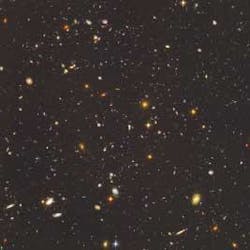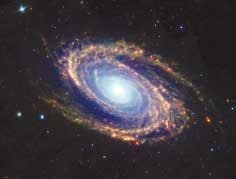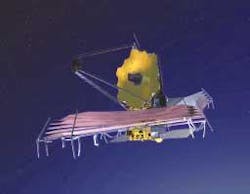Space-based telescopes take astronomers places they have never gone before
From Hubble's 'humble' beginnings, space telescopes are moving deeper into the infrared spectrum, collecting images and information from around the galaxy and beyond.
Adaptive optics and laser guide stars have dominated the field of astronomy for the past two years (see Laser Focus World, April 2004, p. 77). But while these technologies are revolutionizing the ability of ground-based telescopes to image beyond the Earth's atmosphere, additional advances in the design and construction of space-based telescopes are having an equally significant impact on deep-space research. Hubble may have been the first, and so far most productive, space telescope, but there are many others—some already in space, others in various stages of development and deployment—that are providing scientists with new insights into the origins of the universe and the ways in which planets, stars, and galaxies form.
"If you build a telescope on the ground versus putting it into space, the cost is typically 30 to 100 times higher to put a telescope into space," said Marc Postman, deputy head of the community missions office at the Space Telescope Science Institute (STSI; Baltimore, MD). "But there are key advantages that these telescopes have over ground-based telescopes, and agencies like NASA have decided that the benefits are worth the cost."
The biggest advantage from a scientific point of view is the lack of atmosphere, which makes it possible to see things in space that are otherwise blocked at certain wavelengths when trying to view them from the ground. By getting above the atmosphere, the angular resolution of a telescope is limited only by the optics on the telescope. Ground-based telescopes can seldom provide resolution better than 0.5 to 1 arcsec; the resolution of the Hubble Space Telescope, which orbits about 375 miles above the Earth, is 0.05 to 0.1 arcsec.
In addition, going out into space reduces the temperature at which the telescope operates, further improving image resolution and the performance of the detector arrays and other optoelectronic devices on board. And, of course, it is much darker in space than it is on the ground, which makes it easier to see objects that are far away, especially in the near-IR (see Fig. 1).
"What we want to do is take advantage of the fact that, from space, it is cold, dark, and you can observe all these different objects in much better ways than you can ever do from the ground," said Charles Beichman, formerly chief scientist for astronomy and physics at the Jet Propulsion Laboratory (JPL; Pasadena, CA) and now director of the Michaelson Science Center (California Institute of Technology, Pasadena). "Adaptive optics and guide stars are really meant to allow you to get the full angular resolution capabilities of the big ground-based telescopes; in space, we are taking advantage of our access to wavelengths that, from Earth, are 'blocked' by the atmosphere."
Breaking new ground
The official history of space-based astronomy can be traced back to 1946, when U.S. astrophysicist Lyman Spitzer proposed that a telescope in space would reveal much clearer images of far-off objects than ground-based telescopes ever could. But it took until the 1970s before the European Space Agency (ESA) and NASA began developing the first space telescope, which was eventually named after American astronomer Edwin Hubble.
Today the 2.5-m Hubble Space Telescope is still in orbit and still collecting and transmitting images every day. Its basic design includes an optical assembly with a primary mirror, a secondary mirror to redirect the light into an instrument bay, and the instruments in the bay itself (see Fig. 2). The Hubble instrument bay currently houses five optical systems: the Wide Field Camera 3 (WFC3), which offers two channels to allow imaging from the near-UV to the near-IR; the Cosmic Origins Spectrograph (COS), which is nearly 20 times more sensitive in the far-UV than previous Hubble spectrographs; the Advanced Camera for Surveys (ACS), a phone booth–sized instrument that is sensitive to wavelengths ranging from UV to the far-red (115 to 1050 nm); the Space Telescope Imaging Spectrograph (STIS), a two-dimensional spectrograph; and the Near-infrared Camera and Multi-object Spectrometer (NICMOS), which observes in the near-IR spectral region with three cameras viewing three adjacent fields of view of different image scales.
Despite Hubble's groundbreaking accomplishments, astronomers are keen to see what images the next generation of space-based telescopes might yield, especially in the mid- and near-IR. Thus, missions such as Cassini, which is currently exploring Saturn, and Messenger, which launched this summer on a mission to study Mercury, are loaded with cameras, imagers, spectrographs, and supporting optoelectronic devices designed to give scientists a more detailed look at these planets (see Laser Focus World, August 2004, p. 28).
Other telescopes are intended to do more general deep-space research. The Spitzer Space Telescope, for example, is a small beryllium telescope (only 85 cm) that uses IR cameras to see structures hidden by dust in galaxies, separating warm dust from hotter stars (see Fig. 3). Launched in August 2003, Spitzer has so far demonstrated an amazing ability to reveal previously unseen galaxies and galactic events that appear to be shrouded in dust that blocks most of their visible light or that are so far away that their visible and UV light is shifted into the deep-IR.
"The big-scope guys look down on us, but we like to say that size doesn't matter—being cold matters," Beichman said. "Being cold and in space gives a huge advantage."
Spitzer is a cryogenically cooled infrared observatory that carries three instruments in an Earth-trailing, heliocentric orbit on a mission that will last around five years, depending on how long the spacecraft's supply of liquid helium (used to keep the imaging systems close to absolute zero) lasts. The Spitzer instruments include a far-IR camera, the Multiband Imaging Photometer, that detects planetary debris systems around sun-like stars; the Infrared Array Camera, a near- to mid-IR camera that works in four wavelengths between 3 and 8 µm; and the Infrared Spectrograph, which uses detector arrays to obtain a low-resolution spectrum of an object and look at the "fingerprints" of gases, minerals, ices, and so on.
"We want the telescope to be very cold so we want it to go away from the Earth, which acts like an infrared heat lamp," he said. "Spitzer is in an orbit that drifts away from the Earth so that in a year it is 10 million miles away. Solar arrays block the sunlight so that the whole telescope cools to about 45 to 50 degrees above absolute zero; so instead of thousands of liters of helium we need just a few hundred liters."
Bigger, brighter, better
Given the lead time needed to fund, design, build, and test each generation of space telescope, several new projects are already well in the works. The Space Interferometry Mission (SIM), for example, expected to launch in 2009, will use optical interferometry to determine the positions and distances of stars several hundred times more accurately than previous programs and to probe nearby stars for Earth-sized planets.
The highest-profile space-telescope project under construction is the James Webb Space Telescope (JWST), a joint effort between NASA, the ESA, and the Canadian Space Agency (CSA) that is scheduled to launch in 2011. The JWST is a 6-m telescope that, once in space, should be able to make observations 10,000 times faster than Spitzer and to see objects 400 times fainter than those visible using the largest Earth-based telescopes.
Such design specs do not come without their challenges, however; in particular, the JWST team must figure out how to put an 8-m mirror into a standard-sized rocket and then, once in space, deploy it into the most appropriate shape. The trend in ground-based telescopes is not to build the primary mirror as a single piece of glass but as an array of mirrors. The Keck telescope in Hawaii, for example, is actually 36 small mirrors that are linked via actuators and operated via computer. The computer continuously adjusts the positions and angles to ensure that all 36 mirrors essentially take on the shape of a single 10-m mirror.
"One of the biggest challenges of the JWST is: can we make it compact enough to fit on currently available launch vehicles?" Postman said. "The only way to fit an 8-m mirror on any current rocket is to 'fold it up' and then deploy it when it gets into space. And this folding/unfolding is something that has not been done before."
The JWST also features several next-generation instruments, including the Mid-Infrared Instrument (MIRI), which will be used to study distant stellar populations, star formations, comets, and other objects in space. NASA and ESA will jointly build MIRI, which is being designed to provide imaging and spectroscopy at 5 to 28 µm, comprising an imager and an integral field-unit spectrometer (IFUs) to provide broad- and narrow-band imaging, coronagraphy, and prism low-resolution slit spectroscopy from 5 to 10 µm. The IFUs provide four simultaneous fields of view, ranging from 3.0 × 3.9 arcsec to 6.7 × 7.7 arcsec with increasing wavelength, with pixel sizes ranging from 0.2 to 0.65 arcsec. The spectrograph uses two 1024 × 1024-pixel Si:As sensor chip assemblies.
The ESA is also funding development of the NIRSPEC (Near-Infrared Multi-Object Spectrograph), which will operate in the near-IR (0.6 to 5 µm) range to study galaxy formation, clustering, chemical abundances, star formation, galactic nuclei, and measurements of the initial mass function of stars. The CSA is providing scientific support for both the NIRSPEC and NIRCAM (Near Infrared Camera), a third instrument on the JWST that will cover a field of 5 arcmin in four different wavelength bands within a range of 1 to 5 µm.
"The JWST is going to be making observations primarily in the near-IR part of the spectrum, between 1 and 8 µm, and will perform better than any of the current 10-m ground-based scopes," Postman said. "In the mid-infrared range, the JWST should produce better quality images than even a 50-m adaptive-optics ground-based scope."
Further out, as part of the Terrestrial Planet Finder (TPF) program that will launch between 2014 and 2020, NASA has chosen to fly two separate missions—the TPF-C and the TPF-I—to take "family portraits" of stars and their orbiting planets and to study those planets to see which might be habitable or which might have life. The TPF-C is a moderate-sized visible-light telescope similar to the 4- by 6-m version currently under study. Coronagraph instrumentation will use a central disc and other specialized techniques to block the glare of a star, allowing detection and characterization of dimmer planets. The TPF-I, a multiple-spacecraft mission carrying 3- to 4-m IR telescopes, will use interferometry to detect and study individual planets orbiting a parent star.




